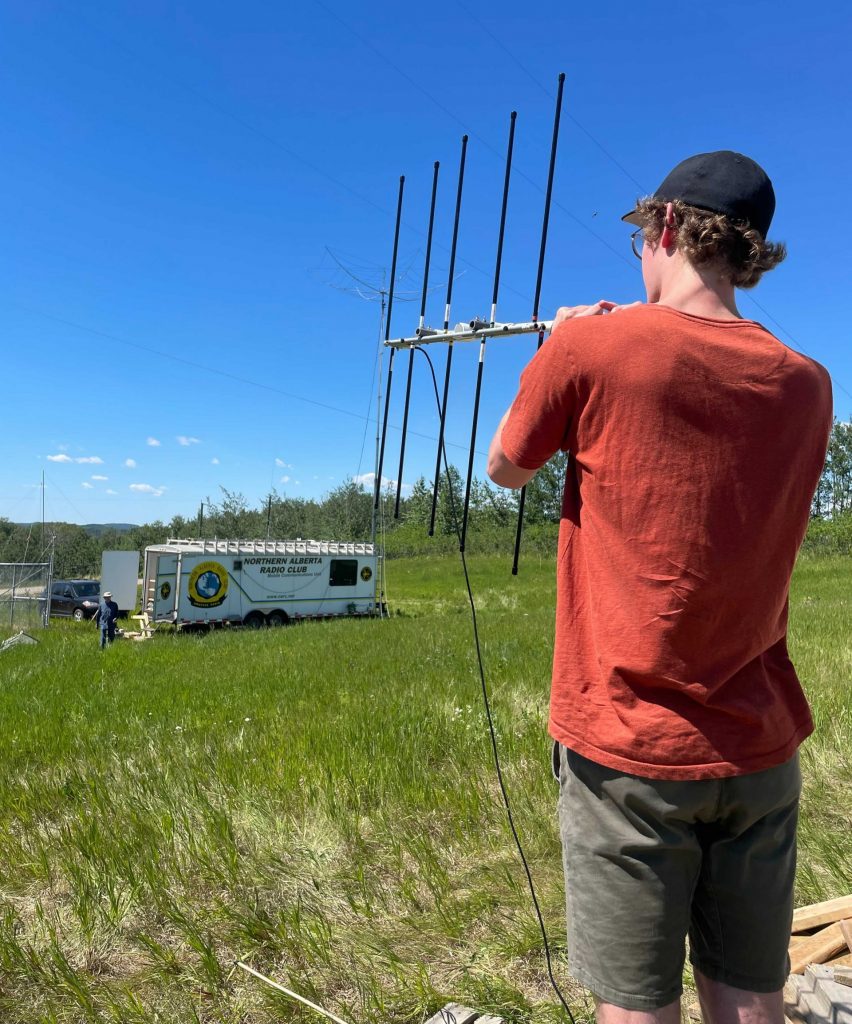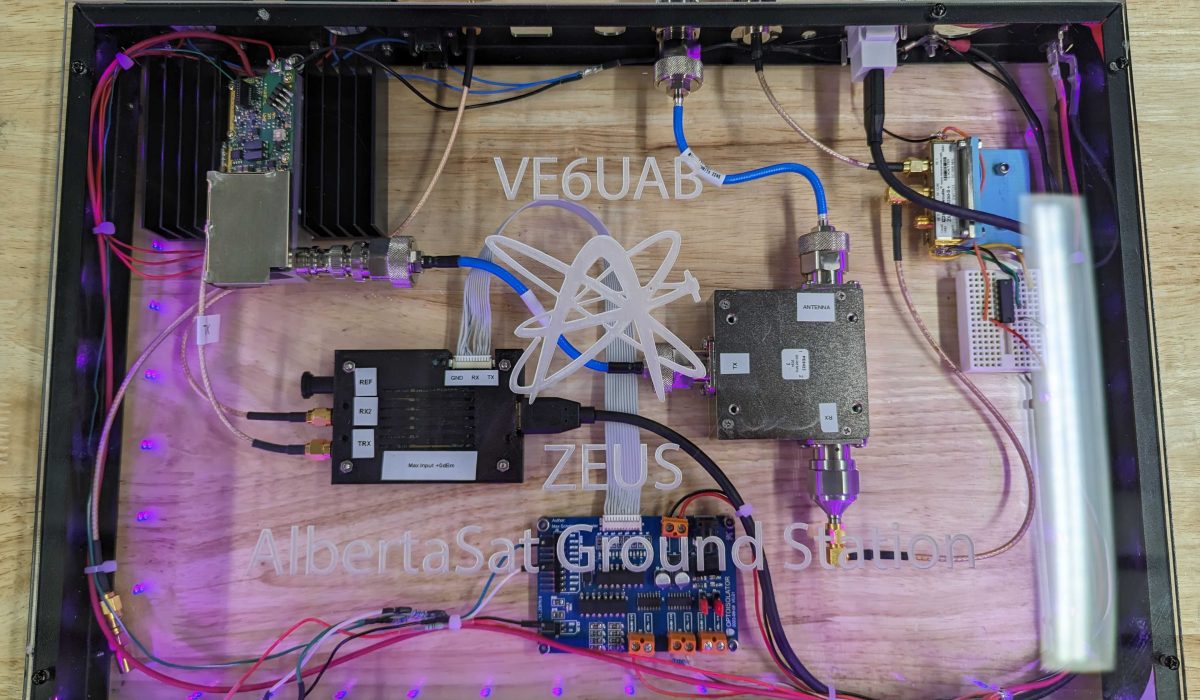Amateur Radio
As of January 2024, AlbertaSat has 24 active members with their Amateur Radio Certification. Many of our missions, including all five satellite missions thus far, the JASPER payload for the BIRDS-X satellite, and our latest balloon mission, use amateur radio.
A programmatic objective for Alberta is to support the amateur radio community in Canada by allowing and encouraging students to gain experience with amateur radio through satellite communications. Throughout the project, the group aims to license and educate students on operating in amateur radio bands. The team will work to achieve this goal alongside our partners at The Northern Alberta Radio Club (NARC).
AlbertaSat also participates in many community amateur radio events, particularly through our partnership with NARC. This includes presenting at events such as the City of Edmonton’s Get Ready in the Park event, NARC’s 100-year anniversary celebration, and NARC field days.


Ex-Alta 3
Ex-Alta 3 Ground Stations
For our satellite missions, AlbertaSat uses two open source, in-house ground stations. See more information about our UHF ground station on our facilities page. Both our ground stations are based off the Ettus B200-mini SDR (Software Defined Radio), and the associated GNU Radio flowgraph is hosted on our Github page.
Ex-Alta 3 Beacons
Ex-Alta 3 will transmit satellite telemetry beacons as AX.25 packets. This will allow the amateur radio community to receive beacon packets from the satellite. More information for amateurs interested in receiving and decoding Ex-Alta 3 beacons will be made available as the project matures.

DEBORA Balloon Mission
DEBORA used APRS (144.390 MHz) to track a high altitude balloon across Alberta. See more information on DEBORA here.
BIRDS-X Jasper APRS Payload
AlbertaSat together with CalgaryToSpace collaborated to design, build and test an APRS board for the BIRDS-X competiton ran by Kyushu Institute of Technology (Kyutech) and the Association for Radio Digital Communications (ARDC). This board is cable of receiving amateur radio and either transmitting them back down immediately or storing them and sending them to the main onboard computer. This board was designed with accessibility in mind, and manufactured for less than $1000. Both the designs and the software are open source and hosted on the AlbertaSat GitHub. The project is set to launch in 2025.
* This section is no longer being updated as of January 1, 2024. The three Northern SPIRIT satellites have now deorbited. *
About the Satellite
Ex-Alta 2, AuroraSat, and YukonSat are registered with the International Telecommunications Union (ITU) under an amateur radio designation. The satellites’ callsigns are:
- Ex-Alta 2: VE6UAB
- YukonSat: VY1YKU
- AuroraSat: VE8ARI
The satellites have been assigned by space-track.org the following NORAD Catalog Numbers:
- Ex-Alta 2: 56313
- AuroraSat: 56312
- YukonSat: 56316
Ex-Alta 2 was deployed together with ArkSat 1 (56311) and Lightcube (56314)
YukonSat and AuroraSat were deployed together with Neudose (56315).
We suspect that the correct assignment is:
- ArkSat 1 : 56311
- Lightcube : 56312
- Ex-Alta 2 : 56313
- Neudose : 56314
- AuroraSat : 56315
- YukonSat : 56316
Nominal service will be QPSK on 437.875 MHz for all three satellites.
Deployment: 12:05 UTC April 24th, 2023
First Beacon: July 13, 2023
The Northern SPIRIT satellites are equipped to do AX.25.
*This section is no longer being updated. Ex-Alta 1 has since deorbited.*
About the Satellite
Ex-Alta 1 was registered with the ITU under an amateur radio designation. Our satellite callsign is ON03CA. (Oscar November Zero Three Charlie Alpha).
Nominal service was 4k8 GMSK on 436.705 MHz. Faster service could be 9k6 or 19k2 GMSK on 436.705 MHz, but usually just over Canada.
Current expected service: Deorbited
Deployment: 08:55 UTC May 26, 2017.
First Beacon: Received by KR01 team, received and decoded by JA0CAW! See https://albertasat.ca/ex-alta-1-beacon-format/ for details.
Ex-Alta 1 did not use AX.25. Instead, it used a CCSDS-derived packet structure that encloses the Cubesat Space Protocol originally developed by Aalborg University and Gomspace.
Information on this is available through several websites. A few are linked here:
https://en.wikipedia.org/wiki/Cubesat_Space_Protocol
https://github.com/libcsp/libcsp
How to Track
Most satellites are tracked by radio detection or triangulation. The knowledge gained on the satellite’s position is published in the Two Line Element format. . Ex-Alta 1 was deployed from the International Space Station, so that was a good place to start until we got better tracking information.
TLE:
Ex-Alta 1 gets new TLE’s daily. Check out http://www.n2yo.com/satellite/?s=42734
Updated May 26, 2017.
Software such as Orbitron or GPredict can be used on personal computers, and the QB50 mission server can be used to visualize locations in real time on any device.
Check out the mission server homepage for a live map of all QB50 satellites and ground stations!
How to Decode
A very useful blog to read is available from Daniel Estévez/EA4GPZ/MOHXM. This blog details contacts with GOMX-3, which flew the same radio as Ex-Alta 1. While the beacon format and information sent during downlink are not similar, the modulation, encoding, antenna, and protocol are identical. Read about it here, and try searching for GOMX to see all the relevant blog posts.
Also from EA4GPZ is a complete git repository with GNURadio libraries that can be used to decode CSP packets from Ex-Alta 1 with minor changes.
https://github.com/daniestevez/gr-satellites
The beacon format for Ex-Alta 1 can be found on a dedicated page here. The beacon is programmed to broadcast every 30 seconds.
https://albertasat.ca/ex-alta-1-beacon-format/
If you need more information for your setup to successfully receive and decode signals from Ex-Alta 1, please use the Contact Us page. We’re happy to share what we have.
How to Contribute
Any files, recordings, or information collected by radio amateurs can be uploaded to the QB50 mission server through the link below. Be sure to select the correct satellite – be it Ex-Alta 1 or any other QB50 satellite – from the dropdown menu. Also select the upload type. An account on the mission server website is required so that all uploads can be matched to a name or callsign, and a running tally of successful contacts can be maintained.
https://upload.qb50.eu/upload/
Any further questions or concerns can be sent to the AlbertaSat team via the Contact Us page. We can normally respond within 24 hours.
Our Hardware
The primary radio for interfacing with the satellite is an ground station copy of the one being flown. We also have an Ettus B200mini for interfacing with other satellites.
Currently we are able to transmit and receive in the UHF band, and receive only in the VHF band.
We have a webcam streaming photos from the roof where our antennas are located. (If nothing appears in the feed, the mast may be lowered for maintenance.)
http://129.128.208.184/cgi-bin/video.cgi
This section was written by Collin Cupido/VA6ISS. AlbertaSat has over 30 members with basic amateur radio certification and about 10 members with advanced amateur radio certification – all of whom are excited to learn and share in the field of amateur radio.
https://web.archive.org/web/20180904015259/http://129.128.208.184/cgi-bin/video.cgi
